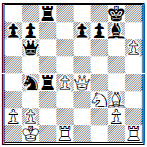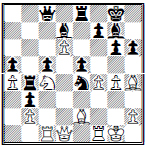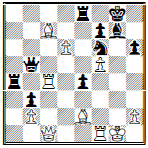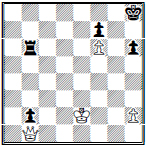IM Jack Peters is a former Massachusetts champion who currently lives in California.
John Hillery, the premier organizer of Southern California tournaments for the last decade, died Sept. 20 at his home in Hollywood, California. He was 58. Some of you remember John from his time in Massachusetts in the 1970s. Perhaps I can give you more insight into his life. He helped shape Southern California chess for nearly 30 years.
John grew up in Lynn. As a teenager, his great passion was acting. He didn’t get interested in chess until he attended Northeastern University in Boston and an illness kept him from performing with the drama club.
That was the “Fischer boom” era of the early 1970s, and John plunged into Boston chess enthusiastically. I met him in the Boylston Chess Club. He was distinctive even then, wearing a suit and tie while most young people dressed colorfully and grew their hair long.
When the editor of Chess Horizons asked readers to submit their best games, John, then rated Class D, sent in one of his. Years later, I blamed him for turning me into a chess writer because he shamed me into making my first contribution to Chess Horizons.
John progressed steadily, earning a master title in 1979 and taking his first steps toward promoting chess by joining the MACA board. Amid the chaos and rancor of MACA meetings, John’s calm manner and adherence to formality stood out.
He visited Los Angeles, apparently on a whim, in 1981 and stayed for the rest of his life. He was a regular participant in FIDE-rated Futurities at The Chess Set, Lina Grumette’s legendary Hollywood club, although he played less frequently in open tournaments. His rating peaked above 2300. More recently, he took up correspondence chess and achieved a master’s rating.
John began a new chess phase in the early 1980s by serving as an assistant TD at various tournaments. Soon he was on his way to becoming a National Tournament Director and an International Arbiter, nationally esteemed for his encyclopedic knowledge of USCF rules. No other TD was as erudite or as steadfastly impartial. I cannot recall criticism of a single decision by John.
After a successful first stint as Rank and File editor, John moved to USCF headquarters in New Windsor, New York, to work as Chess Life assistant editor. I assumed that he would eventually earn a promotion to editor; he certainly had the skills for it. Perhaps John thought differently, because he kept paying rent on his unused Hollywood apartment for the two years he lived in New Windsor.
He was right - the job offer never materialized. In my opinion, this was tragic for all concerned. The USCF went through a series of editors who struggled with the demands of the job, while John grew frustrated waiting for another chance at his dream job.
His stint in New Windsor prompted one positive change – John learned to use a computer, becoming an expert desktop publisher and learning enough HTML to create several websites. He put out Rank and File, the Southern California Chess Federation’s magazine, almost single-handedly, doing all of the editing and layout and writing most of the articles.
In the last decade, John founded “Western Chess” to run his own tournaments. His attempts to make money as an organizer fared poorly, as tournament attendance slumped and fees for hotel rental rose. Realizing that scholastic events were more likely to turn a profit, he devoted more attention to scholastic tournaments.
John surprised me again by attending the 2009 USCF meeting in Indianapolis. Few players would want to sit through a day and a half of tedious meetings and boring speeches, but John spent hundreds of dollars to go and “set the idiots straight.” He accomplished his task with humor, as you can see at his Western Chess blog. He administered a second dose of rational thinking this summer at the 2010 U.S. Open in Irvine, California.
Southern California tournaments offer amenities not found elsewhere. Give John credit for most of the best innovations. John served as chief director of our state championship, an invitational round robin for many years, and helped with fundraising. Most of our tournaments offer brilliancy or best game prizes, a practice John began in the 1980s. All scoresheets collected are posted online within a few days, thanks to John. And John’s tournaments were among the first to post standings online every evening. Tournament directors, like umpires, attract attention mostly by their errors. John was often overlooked because of the excellence of his work. Typically, he cringed when praised, because he felt that he was merely satisfying the standard for the job. John, you were too modest. Well done!
White: Ivars Dahlberg
Black: John Hillery
Star Warriors II Futurity,
Hollywood 1982
Notes by IM!Jack Peters
1 c4 c6 2 Nc3 d5 3 d4 Nf6 4 Bg5 An unusual treatment of the Slav Defense. Ne4 5 Nxe4 dxe4 6 Qd2 Bf5 7 e3 h6 8 Bh4 g5 Accepting a weakened Kingside in return for rapid development. 9 Bg3 Bg7 10 0-0-0 Sharpest. Na6 11 f3 Also 11 Ne2 c5 12 a3 Qb6 13 d5 should keep an edge. c5 12 fxe4 Bxe4 13 Bd3 Bxd3 14 Qxd3 Rc8 15 Kb1?! Underestimating Black’s counterattack. Correct is 15 d5 Qb6 16 Qe2. Qb6 16 h4? White can maintain equality only by 16 Nf3 Nb4 17 Qe4! (very dangerous is 17 Qb3? Qg6+ 18 Kc1 b5! 19 a3 cxd4!) cxd4 18 Be5!. cxd4 17 exd4 Nb4 18 Qe4? Losing. Maybe White can survive 18 c5! Qc6 19 Qf5 e6 20 Qf3 Qa4 21 Qb3. Rxc4 19 Nf3 0-0! Castling into the fire, but White gets cooked first. 20 hxg5 Rfc8 21 gxh6 If 21 a3, Black wins the Queen by 21…Na2! 22 Kxa2 Rc2 23 Rb1 R8c3! 24 Ka1 Qb3 (threatening 25...Qxa3+) 25 Qxe7 Bf8.

Nxa2! Anticipating 22 Kxa2 Ra4+ 23 Kb1 Qb3, mating. Or, if 22 Qg4, Black stops White’s threat by 22…Nc3+ 23 Kc2 Nxd1+ 24 Kxd1 Qb3+ 25 Ke2 Rc2+ 26 Kf1 Qd3+ 27 Kg1 Qe3+ 28 Kh2 Qxh6+. 22 Be1 Rc1+ 23 Kxa2 Qa6+ 24 Ba5 No better is 24 Kb3 R8c4. Qxa5+ 25 Kb3 Qb5+ 26 Ka3 R8c3+!, White Resigns.
White: John Hillery
Black: Michael Wierzbicki,
Golden Knights Championship,
correspondence 1989-1990
Notes by IM!Jack Peters
1 d4 Nf6 2 c4 e6 3 Nf3 c5 4 d5 exd5 5 cxd5 d6 The Modern Benoni. 6 Nc3 g6 7 e4 Bg7 8 Bg5 A sideline, but with some venom. h6 9 Bh4 a6 Black has abandoned 9…g5 10 Bg3 Nh5 11 Bb5+ Kf8 because 12 e5! g4 13 0-0! and 12 e5! Nxg3 13 fxg3 dxe5 14 0-0 give White a powerful attack. 10 Nd2 Harmless is 10 a4 g5 11 Bg3 Nh5. b5 11 Be2 0-0 12 0-0 Nbd7 13 Qc2 Re8 Most natural, but 13…c4 14 b4 cxb3 15 axb3 Bb7 is also adequate. 14 a4 b4 15 Nd1 Heading for c4 via e3. Before White can establish a bind, though, Black has two opportunities for strong counterplay. b3!? The other method is 15…g5 16 Bg3 Nxd5 17 Nc4 Nf4, when 18 Nxd6?! Ne5! 19 Nxe8?? loses to 19…b3. 16 Qd3 Black does not fear 16 Qxb3 g5 17 Bg3 Nxe4 18 Nxe4 Rxe4 19 Qc2 Nf6. Rb8 17 f4 Safer are 17 Nc3 and 17 Ne3. Rb4 18 Nc4 Nb6 19 Nde3 Nxc4 20 Nxc4 a5! Nunn’s recommendation. The fight intensifies, and Black’s chances are no worse. 21 Rac1 As 21 e5? Ba6 favors Black. Qc7 The computer likes 21…Qd7 22 e5 dxe5 23 fxe5 Nxd5, but 24 Bg3, preparing 25 Nd6, retakes the initiative. A second alternative, 21…Ba6 22 Qf3 Bxc4 23 Bxc4 Qd7!?, invites the exchange sacrifice 24 Bb5? Rxb5 25 axb5 Nxe4, when Black’s Bishop will emerge at d4. White must find the answer 24 Be1! Nxe4 25 Bxb4 cxb4 26 Bb5 Qa7+ 27 Kh1 Re7 28 f5 to maintain the dynamic balance. 22 e5 Bf5 23 Qd2 Ne4 24 Qd1 dxe5 25 g4 Bd7 26 d6 Qc8 Not bad, but Black seems to obtain an edge by 26…Qb7 27 f5 gxf5 28 gxf5 Bf6.

27 f5!Anyway. gxf5 28 gxf5 Nf6?! The complicated 28…Bxf5 29 Rxf5 Qxf5 30 d7 leads to a draw by 30…Qg6+! 31 Kf1 (not 31 Kh1? Rd8 32 Bxd8? Nf2 mate) Qf5+ 32 Kg2 Qg6+ 33 Kf1, unless White dares to risk 33 Bg4 Ra8 34 d8Q+ Rxd8 35 Qxd8+ Kh7 36 Kh3 h5 37 Bc8. 29 Be1 Rb8 Acquiescing to a small disadvantage. A similar evaluation applies to 29…Rb7 30 Nxa5 Rb8 31 Rc4 Bxf5 32 Nxb3. Black spotted the problem with 29…Bxf5? 30 Bxb4 Bc2?, his original intention. White would win with 31 d7! Nxd7 32 Qd5, refuting 32…Nf6 most elegantly by 33 Rxf6 Bxf6 34 Nd6 Qe6 35 Nxe8! Qxd5 36 Nxf6+. 30 Bxa5 Bxa4 Not 31…Bxf5? 32 Nb6. 31 Bc7 Rb4 32 Nb6 Qb7 33 Nxa4 Rxa4 34 Rc4!? Black gets plenty of compensation from 34 d7?! Rd4! 35 dxe8Q+ Nxe8. Qb5! As 35 d7 Nxd7 36 Rd4 Qxe2 37 Qxe2 Rxd4 should hold the draw. 35 Qc1 e4!? Making White worry about the safety of his King. For example, 36 Rxe4? Qc6 37 Rxe8+ Nxe8 creates the disturbing threat of 38…Bd4+. 36 Rc2 c4 Easiest is 36…Qb4, when 37 Rc4 Qb5 repeats. Instead, 37 Rxc5? Qd4+ 38 Kh1 e3 would return the advantage to Black. 37 Rxc4

Nd5?? Fatal. After 37…e3 38 Rxa4 Qxa4, White could get swindled by 39 Qc5? Nd7! 40 Qb5? Qxb5 41 Bxb5 Bxb2!, but the correct 39 Qc4 Qxc4 40 Bxc4 Re4 41 Be2 Nd7 leads to a well-deserved draw. 38 Rd1! From this point, Hillery foresaw the artistic finish. Nf6 Insufficient are 38…Nxc7 39 dxc7 and 38…Ra7 39 Rxe4. Even the trickier 38…Ra2!? fails, to 39 Qd2! Rxb2 40 Qxd5 Qxd5 41 Rxd5 Rxe2 42 d7 Rf8 43 d8Q b2 44 Qxf8+ Kxf8 45 Rd1. 39 d7 Nxd7 40 Rxe4 Qxe2 41 Rxe2 Rxe2 42 Qc6 Rd4 Too many Black pieces are loose after 42…Bd4+ 43 Kf1 Rf2+ 44 Ke1. If 44…Nc5, easiest is 45 Qe8+ Kg7 46 Be5+. 43 Rxd4 Bxd4+ 44 Kf1 Again, Black cannot coordinate his pieces after 44…Rf2+ 45 Ke1. White refutes 45…Nf8 by 46 Bd6 Rxb2 47 Qe8 Bg7 48 f6. Rxb2 The best chance, as the b-pawn is formidable. 45 Qxd7 Rf2+ 46 Ke1 b2 47 Qe8+ Not 47 Qxd4?? Rc2!, and Black wins. Kg7 If 47…Kh7 48 Qxf7+ Bg7, White maneuvers the Queen into position by 49 Qg6+ Kg8 50 Qe6+ Kh8 51 Qe8+ Kh7 52 Qe4, then finishes with 52…Rg2 53 f6+ Kg8 54 Qe6+ Kh7 55 Qf5+ Kg8 56 f7+ Kh8 57 Be5. 48 Be5+ Bxe5 49 Qxe5+ Kh7 50 Qe4 Rf4 Black cannot reach a “fortress draw” by 50…Rg2 51 f6+ Kh8 52 Kf1 Rg6 because of 53 Qe8+ Rg8 54 Qb5. 51 Qb1! The careless 51 Qb7? Rxf5 52 Qxb2 Kg8 probably draws. Rb4 52 f6+ Kh8 53 Ke2! Threatening 54 Qg1. Less convincing is 53 Kf2? Rb6 54 Kg3 Kg8. Rb6

54 h4!, Black Resigns. White will disrupt Black’s defense by running his King to c5. Because 54…Rxf6? lands in Zugzwang by 55 Qxb2 Kg7 56 h5, Black must resort to 54…h5 55 Ke3 Re6+ (another Zugzwang appears after 55…Rxf6 56 Qxb2 Kg7 57 Qe5!, as 57…Kg6 58 Qg5+ costs Black the Rook) 56 Kd3 Rd6+ 57 Kc4 Rb6 58 Kc5 Rb8. White conquers resistance by 59 Kd6 Rb4 60 Ke7 Kg8 61 Qg1+ Rg4 62 Qh1! Ra4 (or 62…Rb4 63 Qd5) 63 Qg2+ Rg4 64 Qb7! Rxh4 65 Ke8. A grand conception fittingly ends a magnificent game. 
|